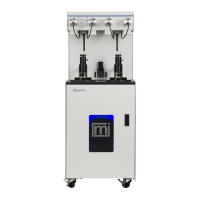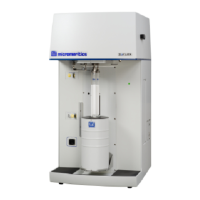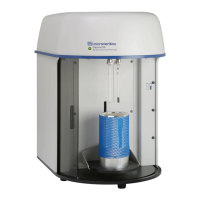ASAP 2460 Operator’s Manual Appendix F
246-42800-01 - Aug 2013 F-7
Pores of 4 Å width, barely larger than the argon atom (3.38 Å), fill at pressures below 1 millitorr. Pores
below 15 Å fill before a monolayer is completed on the surface of the larger pores. In the micropore
size range, the pore volume fills more gradually with pressure and the total shape of the isotherm is
important in characterizing the pore size.
Models Included
Non-Local Density Functional Theory with Density-Independent Weights
N2 - DFT Model
AR - DFT Model
Using the methods of non-local density functional theory, two sets of isotherms have been calculated
to serve as kernel functions for the characterization of porous solids from adsorption data. The model
isotherms are stored in binary format files. These models assume a slit-like pore geometry. The pore
size range from 4.0 to 4000 Å is covered in 91 classes in a geometric progression. The class intervals
are rounded to the nearest 0.02 molecular diameters. A model for the free or external surface is
included to account for unfilled pores. Each of the 92 model isotherms has been calculated at 181 pres-
sure points from near 1x10
-6
to near 1.00 relative pressure.
These models are identical to those supplied with the original DOS version of DFT software. Some
slight difference from the DOS results may be noted when they are applied to the same data due to
improvements in the deconvolution algorithm and better regularization of the current software.
Non-Local Density Functional Theory with Density-Dependent Weights
N2 - Modified Density Functional
Using the modified Tarazona prescription described by Olivier (refer to References, numbers 3 and 4),
model isotherms were calculated for a wide range of adsorptive energies to a relative pressure of 0.6.
The model makes no provision for pore filling in the micropore region. If the sample solid contains
small mesopores, the isotherm data should be truncated (using the Select Data Points window) to a
suitably low relative pressure to avoid trying to fit this region; mesopore filling reports as a large area
of low energy in the calculated distribution of adsorptive potential.
The surface energy is reported in terms of the effective Lennard-Jones interaction parameter, ie., for
the adsorptive/adsorbent pair divided by Boltzmann’s constant. The units are therefore Kelvin.
Geometry: Slit
Substrate: Carbon (graphite)
Category: Porosity
Method: Nitrogen at 77 K; Argon at 87 K
Geometry: Free surface
Substrate: Surface energy
Method: Nitrogen at 77 K
